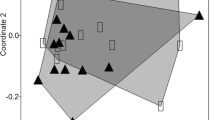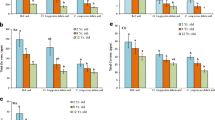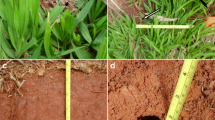Abstract
Purpose
Research has shown that ants are tolerant of environmental pollution and improve the quality of polluted substrates at industrial sites. Here, we assessed the effects of ants on microbial biomass and activity and on the contents of organic matter, nutrients, and heavy metals in an ore-washery sedimentation basin. We also determined whether the effects of ant species were associated with differences in feeding preference and nest construction.
Materials and methods
We examined the effects of Formica sanguinea, Lasius niger, and Tetramorium cf. caespitum on a substrate polluted by high heavy metal contents in an ore-washery sedimentation basin near Chvaletice in the Czech Republic. We collected soil samples from the center of nests and in the surroundings (>3 m from nests) in September 2014 and determined their texture, pH, microbial biomass and activity, and contents of organic matter, mineral nutrients, and heavy metals.
Results and discussion
The properties of ant nests were generally similar to those of the surrounding soil except that microbial activity and the contents of total nitrogen, ammonia, and potassium were higher in F. sanguinea nests than in the surrounding soil. Heavy metal content, which was previously reported to be reduced in ant nests because of buffering by basic cations and because of increased porosity, was not lower in nests than in the surrounding soil.
Conclusions
Nest properties were affected more by F. sanguinea than by L. niger or T. cf. caespitum, probably because F. sanguinea uses substantial quantities of organic matter in constructing its nests, stores debris in the nests, and prefers insects as a food source. The failure to detect additional significant effects of ants might be explained by the high heterogeneity of the substrate and the possibility that the nests were too young to have significantly affected many substrate properties.



Similar content being viewed by others
References
Andersen AN, Majer JN (2004) Ants show the way down under: invertebrates as bioindicators in land management. Front Ecol Environ 2:291–298
Andersen AN, Sparling GP (1997) Ants as bioindicators of restoration success: relationship with soil microbial biomass in the Australian seasonal tropics. Restor Ecol 5:109–114
Andersen AN, Hoffmann BD, Muller WJ, Griffiths AD (2002) Using ants as bioindicators in land management: simplifying assessment of ant community responses. J Appl Ecol 39:8–17
Bartuška M, Frouz J (2015) Carbon accumulation and changes in soil chemistry in reclaimed open-cast coal mining heaps near Sokolov using repeated measurement of chronosequence sites. Eur J Soil Sci 66:104–111
Berg B, McClaugherty C (2008) Plant litter. Springer-Verlag, Berlin Heidelberg
Bradshaw A (1997) Restoration of mined lands – using natural processes. Ecol Eng 8:255–269
Brady NC, Weil RR (2002) The Nature and Properties of Soils. Prentice Hall
Czechowski W, Radchenko A, Czechowska W (2002) The ants (Hymenoptera, Formicidae) of Poland. Museum and Institute of Zoology PAS, Warszawa
Czechowski W, Markó B, Godzińska EJ (2009) Corpse carrying in ants (Hymenoptera: Formicidae): behavioural side effect of aggressive arousal or competitive signaling? Pol J Ecol 57:341–352
Dobrzański J, Dobrzańska J (1975) Ethological studies in the ant Tetramorium caespitum Mayr. I. Foraging and building behavior. Acta Neurobiol Exp 35:299–309
Domisch T, Finér L, Neuvonen S, Niemelä P, Risch AC, Kilpeläinen J, Ohashi M, Jürgensen MF (2009) Foraging activity and dietary spectrum of wood ants (Formica rufa group) and their role in nutrient fluxes in boreal forests. Ecol Entomol 34:369–377
Drager KI, Hirmas DR, Hasiotis ST (2016a) Effects of ant (Formica subsericea) nests on physical and hydrological properties of a fine-textured soil. Soil Sci Soc Am J 80:364–375
Drager KI, Hirmas DR, Hasiotis ST, Bents TC (2016b) Effects of ant (Formica subsericea) nest development on physical and hydrological properties in a coarse-textured soil. Soil Sci 181:166–174
Dvořáčková M (2014) Ants of the sedimentation basin in Chvaletice. MSc. Thesis. Faculty of Science, University of Hradec Králové, Czech Republic (in Czech)
Frouz J, Jílková V (2008) The effect of ants on soil properties and processes (Hymenoptera: Formicidae). Myrmecological News 1:191–199
Frouz J, Holec M, Kalčík J (2003) The effect of Lasius niger (Hymenoptera, Formicidae) ant nest on selected soil chemical properties. Pedobiologia 47:205–212
Grillet L, Mari S, Schmidt W (2013) Iron in seeds—loading pathways and subcellular localization. Front Plant Sci 4:535
Grześ IM (2009) Cadmium regulation by Lasius niger: a contribution to understanding high metal levels in ants. Insect Sci 16:89–92
Grześ IM (2010a) Zinc and cadmium regulation efficiency in three ant species originating from a metal pollution gradient. Bull Environ Contam Toxicol 84:61–65
Grześ IM (2010b) Zinc tolerance in the ant species Myrmica rubra originating from a metal pollution gradient. Eur J Soil Biol 46:87–90
Grześ IM (2010c) Ants and heavy metal pollution—a review. Eur J Soil Biol 46:350–355
Helingerová M, Frouz J, Šantrůčková H (2010) Microbial activity in reclaimed and unreclaimed post-mining sites near Sokolov (Czech Republic). Ecol Eng 36:768–776
Holec M, Frouz J (2005) Ant (Hymenoptera: Formicidae) communities in reclaimed and unreclaimed brown coal mining spoil dumps in the Czech Republic. Pedobiologia 49:345–357
Hölldobler B, Wilson EO (1990) The ants. Springer Verlag, Berlin
Horstmann K (1972) Untersuchungen über den Nahrungswerb der Waldameisen (Formica polyctena Foerster) im Eichenwald. II Abhängigkeit vom Jahresverlauf und vom Nahrungsangebot Oecologia 8:371–390
Insam H, Domsch KH (1988) Relationship between soil organic carbon and microbial biomass on chronosequences of reclamation sites. Microbial Ecol 15:177–188
Jarešová I, Kovář P (2004) Interactions between ants and plants during vegetation succession in the abandoned ore-washery sedimentation basin in Chvaletice. In: Kovář P (ed) Natural recovery of human-made deposits in landscape (biotic interactions and ore/ash-slag artificial ecosystems). Academia, Prague, pp 300–310
Jílková V, Matějíček L, Frouz J (2011) Changes in the pH and other soil chemical parameters in soil surrounding wood ant (Formica polyctena) nests. Eur J Soil Biol 47:72–76
Jílková V, Šebek O, Frouz J (2012) Mechanisms of pH change in wood ant (Formica polyctena) nests. Pedobiologia 55:247–251
Jones CG, Lawton JH, Shachak M (1994) Organisms as ecosystem engineers. Oikos 69:373–386
Jordan WR, Gilpin ME, Aber JD (1987) Restoration ecology: a synthetic approach to ecological research. Cambridge University Press, Cambridge
Jouquet P, Dauber J, Lagerlöf J, Lavelle P, Lepage M (2006) Soil invertebrates as ecosystem engineers: intended and accidental effects on soil and feedback loops. Appl Soil Ecol 32:153–164
Kovář P (2004) Industrial deposits of abandoned sedimentation basins—technology of the origin and vegetation. In: Kovář P (ed) Natural recovery of human-made deposits in landscape (biotic interactions and ore/ash-slag artificial ecosystems). Academia, Prague, pp 15–29
Kovářová M, Frantík T (2004) Decomposition of organic matter on different substrates—laboratory study. In: Kovář P (ed) Natural recovery of human-made deposits in landscape (biotic interactions and ore/ash-slag artificial ecosystems). Academia, Prague, pp 153–175
Krzysztofiak L (1991) The effect of habitat pollution with heavy metals on ant populations and ant-hill soil. Ekol Pol-Pol J Ecol 39:181–202
Ledvina R, Kolář L (1976) Pedology and geology. Czech University of Life Sciences Prague, Czech Republic (in Czech)
Lepš J, Šmilauer P (2016) Biostatistika. České Budějovice, Czech Republic, Episteme
Lobry de Bruyn LA, Conacher AJ (1990) The role of termites and ants in soil modification: a review. Aust J Soil Res 28:55–93
Mehlich A (1953) Determination of P, Ca, Mg, K, Na, and NH4. North Carolina Soil Test Division, Mimeo
Mehlich A (1984) Mehlich 3 soil test extractant: a modification of Mehlich 2 extractant. Commun Soil Sci Plan 15:1409–1416
Mori A, Grasso DA, Le Moli F (2000) Raiding and foraging behavior of the blood-red ant, Formica sanguinea Latr. (Hymenoptera, Formicidae). J Insect Behav 13:421–438
Mori A, Grasso DA, Visicchio R, Le Moli F (2001) Comparison of reproductive strategies and raiding behaviour in facultative and obligatory slave-making ants: the case of Formica sanguinea and Polyergus rufescens. Insect Soc 48:302–314
Nkem JN, Lobry de Bruyn LA, Grant CD, Hulugalle NR (2000) The impact of ant bioturbation and foraging activities on surrounding soil properties. Pedobiologia 44:609–621
Paul EA, Clark FE (1996) Soil microbiology and biochemistry, 2nd edn. Academic Press, San Diego
Petal JM (1978a) Adaptation of ants to industrial pollution. Mem Zoologi 29:99–108
Petal JM (1978b) The role of ants in ecosystems. In: Brian MV (ed) Production ecology of ants and termites. Cambridge University Press, Cambridge, pp 293–325
Petal JM (1980) Ant populations, their regulation and effect on soil in meadows. Ekol Pol-Pol J Ecol 28:297–326
Rauch O (2004) Genesis and characteristics of orewaste sulphate soils at Chvaletice. In: Kovář P (ed) Natural recovery of human-made deposits in landscape (biotic interactions and ore/ash-slag artificial ecosystems). Academia, Prague, pp 46–58
Schinner F, Öhlinger R, Kandeler E, Margesin R (1996) Methods in soil biology. Springer-Verlag, Berlin, Heidelberg
Seifert B (2007) Die Ameisen Mittel- und Nordeuropas. Lutra Verlags- und Vertriebsgesellschaft, Tauer
Sokal RR, Rohlf FJ (1995) Biometry. W. H. Freeman, New York
Sparling GP (1992) Ratio of microbial biomass carbon to soil organic carbon as a sensitive indicator of changes in soil organic matter. Aust J Soil Res 30:195–207
Sparling G, Vojvodic-Vukovic M, Schipper LA (1998) Hot-water-soluble C as a simple measure of labile soil organic matter: the relationship with microbial biomass C. Soil Biol Biochem 30:1469–1472
StatSoft, Inc. (2013) STATISTICA for Windows (Computer program manual). Version 12. Available at: http://www.statsoft.com
Vance ED, Brookes PC, Jenkinson DS (1987) An extraction method for measuring soil microbial biomass C. Soil Biol Biochem 19:703–707
Vos CC, Opdam P (1993) Landscape ecology of a stressed environment. Chapman & Hall, London
Acknowledgements
This study was financially supported by the University of Hradec Králové (Specific Research no. 2114, 2014), Charles University in Prague (project GA UK No. 574213), Czech Academy of Sciences (L200961602) and SoWa RI (LM2015075). Some of the laboratory equipment for this study was purchased from the Operational Programme Prague-Competitiveness (project CZ.2.16/3.1.00/21516). We thank Martin Bartuška and Markéta Dvořáčková for help with substrate sampling, Hana Šimáčková for laboratory analyses, and Pavel Kovář and Ota Rauch for valuable comments.
Author information
Authors and Affiliations
Corresponding author
Additional information
Responsible editor: Qiaoyun Huang
Rights and permissions
About this article
Cite this article
Jílková, V., Pech, P., Mihaljevič, M. et al. Effects of the ants Formica sanguinea, Lasius niger, and Tetramorium cf. caespitum on soil properties in an ore-washery sedimentation basin. J Soils Sediments 17, 2127–2135 (2017). https://doi.org/10.1007/s11368-017-1667-7
Received:
Accepted:
Published:
Issue Date:
DOI: https://doi.org/10.1007/s11368-017-1667-7




